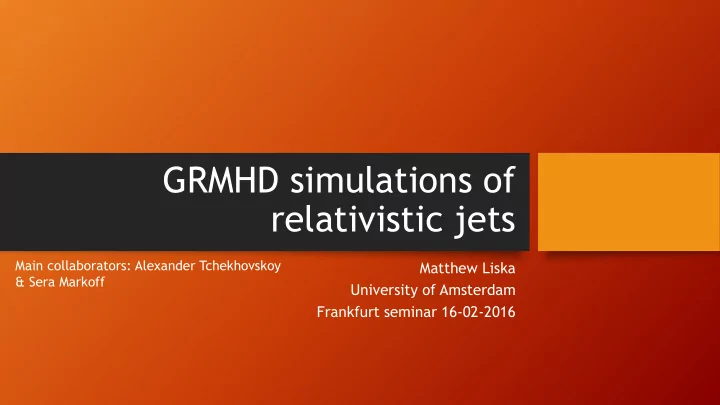

GRMHD simulations of relativistic jets Main collaborators: Alexander Tchekhovskoy Matthew Liska & Sera Markoff University of Amsterdam Frankfurt seminar 16-02-2016
Content • Introducing a new code: HARM-GPU • Introduction to AGN jet physics • Simulations setups • Results
Trends in astrophysical MHD • Use fewer assumptions/include more physical effects • Resolve all relevant distance scales in 3D simulations • Study systems over multiple orders of magnitude in time • We need high performance MHD codes to move on! Credit: SCO Credit: McKinney, 2012
New code: HARM-GPU • Based on well tested HARM GRMHD code • Makes use of GPUs • Various algorithmic enhancements such as better numerical solvers (HLLC) and staggered grid in work • Adaptive grid will be implemented as well
Why GPUs • Non vectorised single core performance reached state of perfection in CPUs and accelerators • Speedup lies in more cores and use of vectorization for CPUs/Accelerators • Vectorization is very difficult in HARM (20.000 instructions per cycle)
How do GPUs work? • Goal is not to complete a single task very fast, but 10 5 -10 7 tasks • Trade circuitry/cache space for more ALU space, but retain huge register size • Rely on 10+ threads per core to keep stream processors busy • Necessitates usage of specialised programming languages (OpenCL/CUDA)
Code performance
Code scaling
My goal: Understanding jet acceleration • Jets convert their magnetic energy (Poynting) flux into mass- energy flux through acceleration, but how and on which scales? • What is the effect of the ambient medium on jet acceleration and shape?
Applications: Cosmic Rays • AGN jets could be a significant contributor to extragalactic cosmic rays and neutrinos (CTA/IceCube) Hubble image of M87 Credit: NASA
Applications: BH feedback • How do jets influence galactic structure formation? Hubble image Virgo cluster AREPO cosmological simulation
When are jets launched?
Blandford & Znajek jets Credit: Alexander Tchekhovskoy
Jet acceleration theory • Situation a bit different when jets get superfast (v> 𝑤 𝐺𝑁𝑇 ) • Conversion of magnetic energy into kinetic energy by reordering of field lines past FMS (fast magnetosonic surface) • Reproducing a realistic collimation profile in simulations is a challenge
Acceleration and collimation of jets Credit: Asada & Nakamura, 2012
Simulations • Assumes a radiatively inefficient sub-eddington rate torus • Assumes axisymmetric ideal MHD • Adds viscosity and resistivity through use of Riemann solver (HLL) • Uses density floors to mass-load the jet • Uses grids that can resolve the substructure of the jet over 5 orders of magnitude
Movie: Toroidal pinch instabilities forming
Configuration • Giant ADAF extending till the Bondi radius of 5 ∗ 10 5 𝑆 𝐻
Results: Jet’s core resolved properly • The inner core (cusp in 𝐶 𝑞 ) is resolved due to high resolution focusing of a static grid � Important for differential collimation
Jet structure
Results: Low res model (left); High res model (right) • μ gives the jet’s theoretically maximum Lorentz factor γ • σ gives jet’s magnetization • δ>1 means that the jet’s opening angle is larger than it’s Mach cone angle
Results: Collimated (left) vs Uncollimated (right) • μ gives the jet’s theoretically maximum Lorentz factor γ • σ gives jet’s magnetization • δ >1 means a causally disconnected jet
My simulations vs other work • Idealised models (Tchekhovkoy et al, 2009; Komissarov et al, 2007/2009) show efficient acceleration • Mckinney et al 2006 observed heating due to toroidal pinch instabilities and found inefficient acceleration • We observe the same toroidal pinch instabilities but no heat, instead the magnetization is higher and the jet becomes chaotic
Origin of break: Toroidal pinch instabilities? Credit: Walker et al, 2008 Credit: Mertens et al, in prep
Standing shock features in jets Credit: NASA
Conclusion • Axisymmetric jet solutions extended by an order of magnitude in distance due to GPU code • Highly disordered magnetic field observed • Toroidal pinch instabilities prevent the jet from accelerating efficiently • Simulations will be extended to 3D, which is very challenging
Future work: Tilted disk simulations • Computationally very challenging • High tilt, long run time and very thin disks most rewarding but highly challenging • Best opportunity to see (inner) disk precession in combination with alignment of inner disk and black hole • Resolving the jet is doable as well in 3D • Tidal disruption event simulations are even more challenging but provide a cleaner result out of first principles
Recommend
More recommend